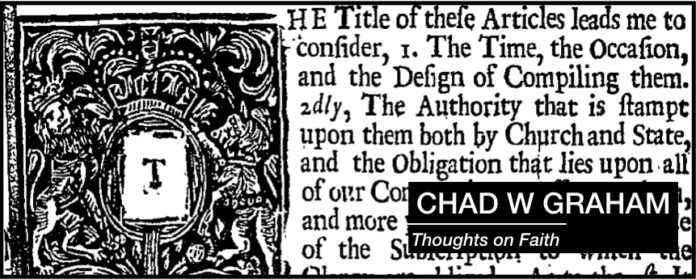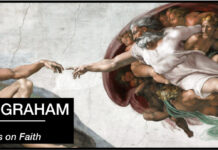The Thirty-nine Articles are the theological standard of the Anglican Communion. Charles I, made it known that he agreed with the “Archbishops and Bishops of both provinces and the whole clergy in Convocation holden at London in the year 1562 for the avoiding of diversities of opinions and for the establishing of consent touching true religion.” He further declared:
That the Articles of the Church of England . . . do contain the true doctrine of the Church of England agreeable to God’s Word: which we do therefore ratify and confirm, requiring all our loving subjects to continue in the uniform profession thereof, and prohibiting the least difference from the said articles. . .
This Declaration is printed in my 2012 Cambridge Standard Edition of the Book of Common Prayer (BCP), as it has been in every proper copy of the central liturgical influence in the English speaking world.
Many years ago, as part of my theology and church history courses, I studied the Articles of Religion, as they are properly titled. I have always appreciated the clarity and brevity of this National Creed.
One devotional book that had a huge impact on me was J.C. Ryle’s Holiness (Amazon; .co.uk; .ca). Later, as a teenage camp counsellor, I took Ryle’s 2 volume Commentary on the Gospel of Luke as my daily reading and found him an insightful guide in coming to a greater knowledge of my Lord and Saviour Jesus Christ (Amazon; .co.uk; .ca).
Ryle on the Thirty-nine Articles
Recently, I began reading his Knots Untied: Being plain statements on disputed points in Religion from the standpoint of an Evangelical Churchman (Amazon; .co.uk; .ca). Once again, I found him insightful and helpful. But one of the most powerful chapters in this book was Ryle’s chapter on the Thirty-nine Articles.
In Ryle’s estimation, the Articles are “the backbone of the Church of England” (48). He clarifies, “I think there ought to be no doubt [that the full title of the Articles] proves that the [they] are intended to be ‘the Church of England’s Confession of Faith.'” (51).
A Bishop in the Church of England, during the Victorian era, he was an inheritor of the evangelical tradition revived by George Whitfield in the 18th century. He makes a powerful case for the central role of the Articles as a guide to biblical faith and as an authoritative reformation creed.
The Role of the 39 Articles in the Church of England is important, though as the Anglican faith has declined theologically in the Western English world, their importance has diminished.
The Origin of the Thirty-nine Articles
Originally it was intended that there would be three parts to the constituency of the Reformed English Church. The Articles of Religion, expanded or explicated in the Book of Homilies (Amazon; .co.uk; .ca) were intended as the doctrinal standard of the Church. The Book of Common Prayer was intended as the worship standard of the church. The Ordinal was to be the discipline standard of the church.
The Articles came first, although as a work in progress, beginning with the 10 Articles of 1536. These were then adapted and augmented several times, reaching their final form in 1571 (at least in English). The Latin text of 1562 is the formal legal edition of the Articles. The Book of Common Prayer was originally published in 1539 although its final form would not be complete until 1662. The Ordinal was added in 1550.
the Articles themselves can be read online. They are also printed with every copy of the Book of Common Prayer (Amazon; .co.uk; .ca).
The Purpose of the Thirty-nine Articles
Martin Davie explains, “The Articles and the model sermons known as the Homilies were intended to set out in broad terms what the faith and practice of the Church of England should be as the basis for teaching, catechesis, and discipline.” (7)
Bishop Ryle explains:
What I deliberately assert is, that the Thirty-nine Articles, were always intended to be, and are at this day, the first, foremost, chief, and principal test of a Churchman, and that in this point of view there there is nothing else that stands on a level witness with them (Ryle, 55).
The very first commentary on the Articles was written by Archbishop Bancroft’s Chaplain Thomas Rogers in 1607. He writes:
The purpose of our Church is best known by the doctrine which she does profess: the doctrine by the Thirty-nine Articles established by Act of Parliament; the Articles by the words whereby they are expressed: and other doctrine than in the said Articles is contained, our Church neither hath nor holdeth, and other sense they cannot yield than their words do impart. (Quoted by Ryle, 57-8).
Further, Bishop Hall says, in his work on “The Old Religion:”
The Church of England, in whose motherhood we have all come to pride ourselves, hath in much wisdom and piety delivered her judgment concerning all necessary points of religion, in so complete a body of divinity as all hearts may rest in. These we read, these we write under, as professing not their truth only, but their sufficiency also. The voice of God our Father, in His Scriptures, and, out of them, the voice of the Church our mother, in her Articles, is that which must both guide and settle our resolutions. Whatsoever is beside these, is either private, or unnecessary, or uncertain. Hall’s Works. Oxford Edition. Vol. ix., p. 308 (quoted by Ryle, 58).
The Value of the Thirty-nine Articles
Now today the establishment Anglican Communion in the West is in decline (see my article on this). This church has obviously forgotten what Roger’s understood. it has “embraced other doctrine that in the said Articles” and it has minimized the place and value of the articles.
In fact, most Anglicans today have little familiarity with the Articles and have been told over and over that they are a historical left over. Lex Orandi, Lex Credendi has been a rallying call, what we pray is what we believe. The Book of Common Prayer, it is asserted, holds the answer to what Anglicans belive. Ryle has shown fairly conclusively, by the Legislation, Case law, history, and testimony of the Bishops of many ages that this is not true.
As Bishop Stillingfleet says in his Unreasonableness of Separation: “This we all say, that the doctrine of the Church of England is contained in the Thirty-nine Articles; and whatever the opinions of private persons may be, this is the standard by which the sense of our Church is to be taken.” London, 4th edition, p. 95. 1631 (quoted by Ryle, 58).
Recently J.I. Packer and Roger Beckwith have carried this case forward in our day. They argue that the neglect of the Articles today is “a problem of integrity” for the church (31). It is time, they argue, “for integrity, for unity and spiritual health . . . to lay hold afresh of the old concept from which we have drifted.” (36).
Reflection on the Thirty-nine Articles
I desire and hope for the success of the great revival of classical Anglican faith tbhrough the GAFCON movement. I believe that many of the resources and much of the heritage held within the Anglican Communion are a vital means of reaching our post-Christian, postmodern culture.
To achieve this, the threefold foundational vision of the movement must be re-learned and re-embraced. Obviously, the language and applications must be modernized so as to communicate to the modern world. But Truth is immortal. As the GAFCON website reminds us:
GAFCON is steadfastly orthodox. We stand by the founding principles and doctrines of the church which are rooted in Scripture as affirmed in the Jerusalem Statement and Declaration which states: “The doctrine of the Church is grounded in the Holy Scriptures and in such teachings of the ancient Fathers and Councils of the Church as are agreeable to the said Scriptures. In particular, such doctrine is to be found in the Thirty-nine Articles of Religion, the Book of Common Prayer and the Ordinal” (source, emphasis added).
“Being Anglican” Church Collins argues, “means a theology, a heritage, something we believe – not an institution we submit to.” (2014. Reformation Anglicanism. Newport Beach: Anglican House Publishers, 128).
Packer and Beckwith conclude, “Nothing better could be wished for the future of Anglicanism, and the well-being of Anglican churched, then that the Articles should regain among us the status which is theirs by theological right” (73).
Select Bibliography for Further Study of the Thirty-nine Articles
Boultree, T.P 1895. A commentary on the thirty-nine articles forming an introduction to the theology of the Church of England. London: Longmans, Green, and Co.
Bray, Gerald. 2009. The Faith We Confess: An Exposition of the Thirty-Nine Articles. London: The Latimer Trust.
Davie, Martin. 2013 Our Inheritance of Faith: A Commentary on the Thirty Nine Articles. Gilead Books Publishing.
Gibson, Edgar C. S, and Church of England. 1904. The Thirty-nine Articles of the Church of England. London: Methuen.
Lightfoot, John. 1890. Text-book of the thirty-nine articles of the Church of England. London: S. Sonnenschein.
Packer, J.I. and R.T. Beckwith. 2006 The Thirty-nine Articles: Their Place and Use Today. London: The Latimer Trust; 2nd edition.






